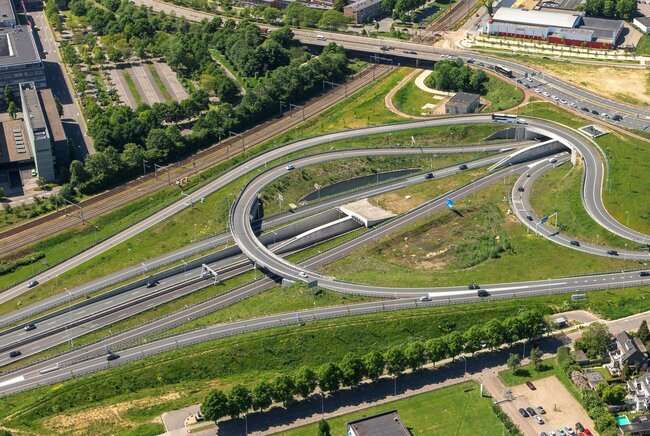Smart algorithms make the design of tunnel control systems much more efficient

It is hard to imagine modern traffic networks without tunnels. They help us bypass rivers and mountains, and make sure traffic doesn’t interfere too much with our daily lives in urban areas. Modern tunnels are highly complex systems that need to be continually monitored to ensure that they are safe for drivers.
Ph.D. researcher Lars Moormann has developed smart tools that make it much easier to come up with efficient controllers for these systems. He will defend his thesis on December 15th at the department of Mechanical Engineering.
Road tunnels play an important role in traffic infrastructure around the world. They are used to bypass rivers and mountains, to improve traffic flow, and to increase quality of life in urban areas. In the Netherlands, a country with the highest population density and densest waterway network in Europe, tunnels are a common feature in traffic infrastructure.
An example of a tunnel that was recently constructed in the Netherlands is the Koning Willem-Alexander tunnel (see above). This tunnel passes underneath the city of Maastricht to increase traffic flow through the city, and improve the quality of life for the residents. A similar tunnel can be found in Roermond.
Safety first
To ensure that drivers can use these underpasses safely, modern tunnels typically contain a myriad of technical installations. Think of smart lighting, ventilation, evacuation systems, fire extinguishing tools, and flood prevention systems. Together, these technical installations form an intricate network that is coordinated by what is known as a supervisory controller. Any failure in these controllers can lead to dangerous situations, or interruptions of the traffic flow, which can last for hours or even days.
“These controllers use digital systems to monitor and control the installations in the tunnel, and then report back through feedback loops using computer algorithms,” explains Lars Moormann, researcher at the Control Systems Technology group. “Of course, there are also human traffic operators, who can manually intervene if necessary, for instance to close off the tunnel in case of an accident or to change a specific traffic light.”
Getting digital controllers to work correctly in a complex environment such as a tunnel is not a trivial matter. “Fortunately, we have ways of automating the design process using a method called supervisory control theory,” says Moormann.
From model to synthesis
The first step of using supervisory control theory is to come up with suitable models of the tunnel and its requirements. To do this, Moormann created a tool that can model a complete road tunnel in a matter of minutes. By specifying the parameters of a tunnel, such as the number of traffic tubes, driving lanes and escape doors, the tool automatically determines which models are needed for that tunnel.
“We then use computer algorithms to automatically derive a specific supervisory controller from the created models,” says Moormann. “This is a complex problem that grows exponentially with the number of system components and parameters. However, because road tunnels tend to be symmetrical, we were able to significantly reduce the complexity of the synthesis problem. After all, if a system contains symmetric subsystems, calculations for supervisor synthesis only need to be performed once.”
Using the new synthesis tool, the researcher improved the performance of the controller synthesis process by 80%.
Testing the controller
The next step was to put the controller to the test in a real-life tunnel system. Before he was able to do so, Moormann had to devise a way to make his controller work with programmable logic controllers (PLCs), which are the hardware platforms that are often used in industry to implement controllers.
A typical road tunnel is controlled by over ten PLCs that all need to communicate with each other, a process which can lead to communication delays. The researcher developed algorithms to reduce the negative impact of these delays on the controller.
Moormann then tested the results of his project on several road tunnels, including the Koning Willem-Alexander tunnel, the Eerste Heinenoord tunnel, and the Swalmen tunnel near Roermond.
“We are very happy with the results. Our research shows that supervisory control theory is not only fast and correct, but also applicable for these types of systems. This means that the methods are ready to be put to use in practice, and can help ensure that the traffic flow in our tunnels remains safe and efficient.”
Cooperation with Rijkswaterstaat
Moormann’s research is part of the MultiWaterWerk (MWW) project, a collaborative project between TU/e and Rijkswaterstaat, the owner of 20 of the total of 27 tunnels in the Netherlands. The project aims to standardize the design of new locks, tunnels and other infrastructure in order to save costs and time.
Part of this includes the synthesis-based methods Moormann used in his project to generate automatic control systems. These methods are becoming increasingly popular as they not only reduce production time but also provide immediate guarantees of correctness.
Light at the end of the tunnel: pure.tue.nl/ws/files/234520776 … 1215_Moormann_hf.pdf
Citation:
Smart algorithms make the design of tunnel control systems much more efficient (2022, December 13)
retrieved 13 December 2022
from https://techxplore.com/news/2022-12-smart-algorithms-tunnel-efficient.html
This document is subject to copyright. Apart from any fair dealing for the purpose of private study or research, no
part may be reproduced without the written permission. The content is provided for information purposes only.
For all the latest Technology News Click Here
For the latest news and updates, follow us on Google News.

